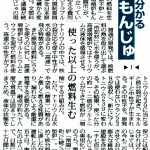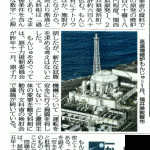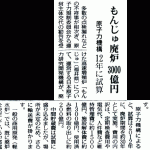Original Japanese written by staffer
The English below written and arranged by Heeday, based on the original Japanese
The English edited by Rev. Dr. Henry French, ELCA
Articles from the February 16th, 2016 editions of the Fukushima Minpo and the February 17th editions of the Fukushima Minpo and Akahata newspapers
▼Click each image to read an English summary of the Japanese article.
It has been learned that the Japan Atomic Energy Agency, the operator of the Monju FBR (Tsuruga, Fukui Pref., Japan, some 62 miles NNE of Kyoto), estimated that decommissioning the FBR could take some 30 years and some JPY300 billion.about The Agency made the estimate in 2012, the year after the 2011 Fukushima meltdown. Said the Agency, “Back then there was a debate on whether or not to let Monju survive, so we made an internal estimate.”
Goliath can die, but —
This discovery, made public for the first time, about how much it could cost to decommission the FBR, makes clear that it will costeveral time more than decommissioning an average light water reactor. The non-operating breeder reactor has been a goliath money-eater, eating up more than JPY1 trillion with almost no power generated. Restarting it, instead of decommissioning it, could cost more than JPY100 billion for repairs, etc. Whether it is left alive or put to death, the goliath will remain a gigantic money-eater.
What is a FBR?
Monju is a fast breeder reactor, which runs on mixed oxide (MOX) fuel, a mixture of plutonium and uranium, and uses “fast” neutrons to cause nuclear fission. (Common light water reactors use slow neutrons.) A FBR generates more plutonium than it consumes for power generation, assuming there is power generation by the plant. Thus, it is called a “breeder.” Japan’s government, calling it the “dream reactor,” treated it as an indispensable component of the nation’s “nuclear fuel cycle,” which also requires a reprocessing plant for used nuclear fuels. Thus, the government has so far spent more than JPY1 trillion of tax money on FBR research and development. In spite of this megabuck spending, the FBR history has been a series of accidents and serious problems. Seldom has it produced any power. In 2012, it was discovered that an equipment checkup at Monju failed to cover many important items. The Nuclear Regulation Authority (NRA,) in May 2013, gave an in-effect stoppage order to the FBR.
So, why has this money-eater been around so far?
The question should be, in fact, why have they not been able to decommission it? Japan already has more than 47 t (103,617 lb.) of plutonium, which can be used to produce several thousands of plutonium warheads. International society allows Japan to have the plutonium, on condition that Japan uses all of it for peaceful purposes—power generation at Monju, etc. Decommissioning Monju would, therefore, cause many in the outside world to suspect that Japan is building nuclear weapons.
They need a “lavatory”
Yet another reason is that the Japanese government wants to build a “lavatory” for used nuclear fuels. A FBR was intended to recycle used nuclear fuels. Now, after all those never-ceasing accidents and problems, the “lavatory” has proven to be non-existent. Still, if the government gave up on this nuclear fuel cycle, it would mean, in effect, that it is admitting that there is no nuclear fuel “lavatory.” Not just the government, but reactor builders and power companies who want to restart existing nuclear power plants want to keep alive the myth that a “lavatory” can be built.
The Japanese author’s wish
Letting Monju survive is obviously just putting off till tomorrow what we should be taking care of today. Japan’s government should not waste any more tax money on this fruitless FBR project. I hope they have the courage to decommission Monju as soon as possible.



